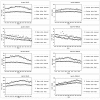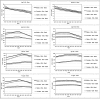Long-term all-sites cancer mortality time trends in Ohio, USA, 1970-2001: differences by race, gender and age
- PMID: 16242021
- PMCID: PMC1277822
- DOI: 10.1186/1471-2407-5-136
Long-term all-sites cancer mortality time trends in Ohio, USA, 1970-2001: differences by race, gender and age
Abstract
Background: There were significant changes in cancer mortality in the USA over the last several decades, in the whole country and in particular states. However, no in depth analysis has been published so far, dealing with changes in mortality time trends in the state of Ohio. Since the state of Ohio belongs to the states of relatively high level of all-sites mortality in both males and females, it is of interest to analyze recent changes in mortality rates, as well as to compare them with the situation in the rest of the USA. The main aim of this study was to analyze, describe and interpret all-sites cancer mortality time trends in the population of the State of Ohio.
Methods: Cancer mortality data by age, sex, race and year for the period 1970-2001 were obtained from the Surveillance Research Program of the National Cancer Institute SEER*Stat software. A joinpoint regression methodology was used to provide estimated annual percentage changes (EAPCs) and to detect points in time where significant changes in the trends occurred.
Results: In both, males and females mortality rates were higher in blacks compared with whites. The difference was bigger in males (39.9%) than in women (23.3%). Mortality rates in Ohio are generally higher than average USA rates--an overall difference was 7.5% in men in 1997-2001, and 6.1% in women. All-sites mortality trends in Ohio and in the whole USA are similar. However, in general, mortality rates in Ohio remained elevated compared with the USA rates throughout the entire analyzed period. The exceptions are the rates in young and middle-aged African Americans.
Conclusion: Although direction of time trends in Ohio are similar in Ohio and the whole US, Ohio still have cancer mortality rates higher than the US average. In addition, there is a significant discrepancy between white and black population of Ohio in all-sites mortality level, with disadvantage for Blacks. To diminish disparities in cancer mortality between African Americans and white inhabitants of Ohio efforts should be focused on increasing knowledge of black people regarding healthy lifestyle and behavioral risk factors, but also on diminishing socioeconomic differences, and last but not least, on better access to medical care.
Figures



Similar articles
-
Why do postmenopausal African-American women not benefit from overall breast cancer mortality decline?Ann Epidemiol. 2006 Mar;16(3):180-90. doi: 10.1016/j.annepidem.2005.04.011. Epub 2005 Oct 20. Ann Epidemiol. 2006. PMID: 16242959
-
Disparities in oral and pharyngeal cancer incidence, mortality and survival among black and white Americans.J Am Dent Assoc. 2006 Feb;137(2):203-12. doi: 10.14219/jada.archive.2006.0146. J Am Dent Assoc. 2006. PMID: 16521387 Free PMC article.
-
Heart Disease Death Rates Among Blacks and Whites Aged ≥35 Years - United States, 1968-2015.MMWR Surveill Summ. 2018 Mar 30;67(5):1-11. doi: 10.15585/mmwr.ss6705a1. MMWR Surveill Summ. 2018. PMID: 29596406 Free PMC article.
-
Revisiting the 1973 report, "Alarming increase of the cancer mortality in the US Black population (1950-1967)".Ethn Dis. 2005 Autumn;15(4):779-85. Ethn Dis. 2005. PMID: 16259508 Review.
-
Cancer incidence and mortality trends among whites in the United States, 1947-84.J Natl Cancer Inst. 1987 Oct;79(4):701-70. J Natl Cancer Inst. 1987. PMID: 3309421 Review.
Cited by
-
Incidence and Mortality Rate of Common Gastrointestinal Cancers in South of Iran, a Population Based Study.Iran J Cancer Prev. 2011 Fall;4(4):163-9. Iran J Cancer Prev. 2011. PMID: 26322193 Free PMC article.
References
-
- Ries LA, Wingo PA, Miller DS, Howe HL, Weir HK, Rosenberg HM, Vernon SW, Cronin K, Edwards BK. The annual report to the nation on the status of cancer, 1973-1997, with a special section on colorectal cancer. Cancer. 2000;88:2398–2424. doi: 10.1002/(SICI)1097-0142(20000515)88:10<2398::AID-CNCR26>3.0.CO;2-I. - DOI - PubMed
-
- Weir HK, Thun MJ, Hankey BF, Ries LA, Howe HL, Wingo PA, Jemal A, Ward E, Anderson RN, Edwards BK. Annual report to the nation on the status of cancer, 1975-2000, featuring the uses of surveillance data for cancer prevention and control. J Natl Cancer Inst. 2003;95:1276–1299. - PubMed
MeSH terms
LinkOut - more resources
Full Text Sources

